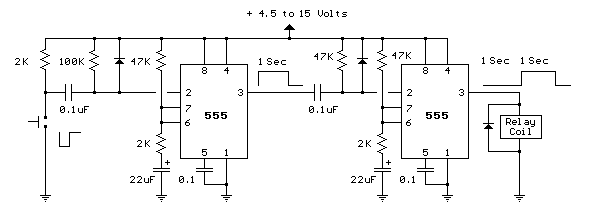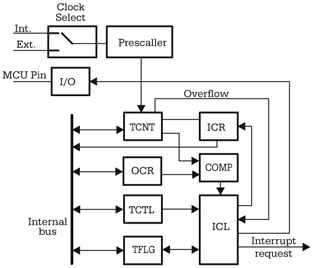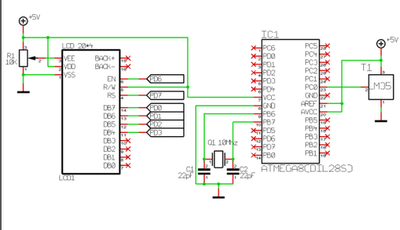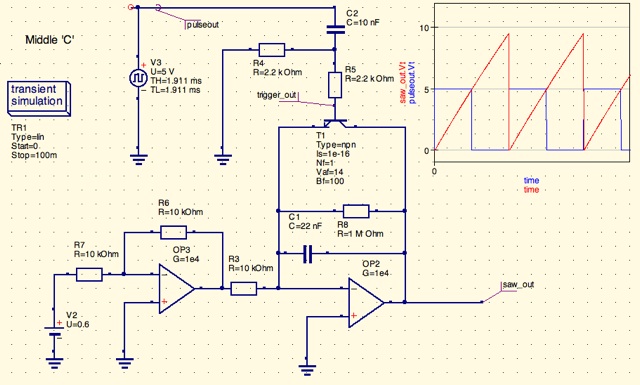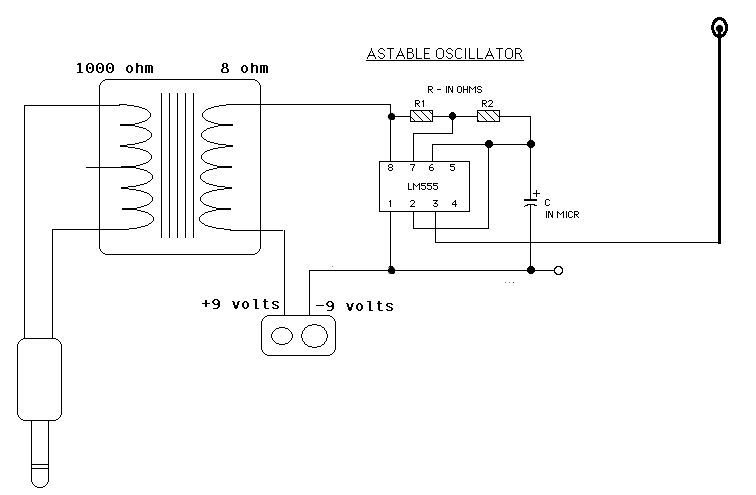
digital logic purpose of diode in this 555 timer application
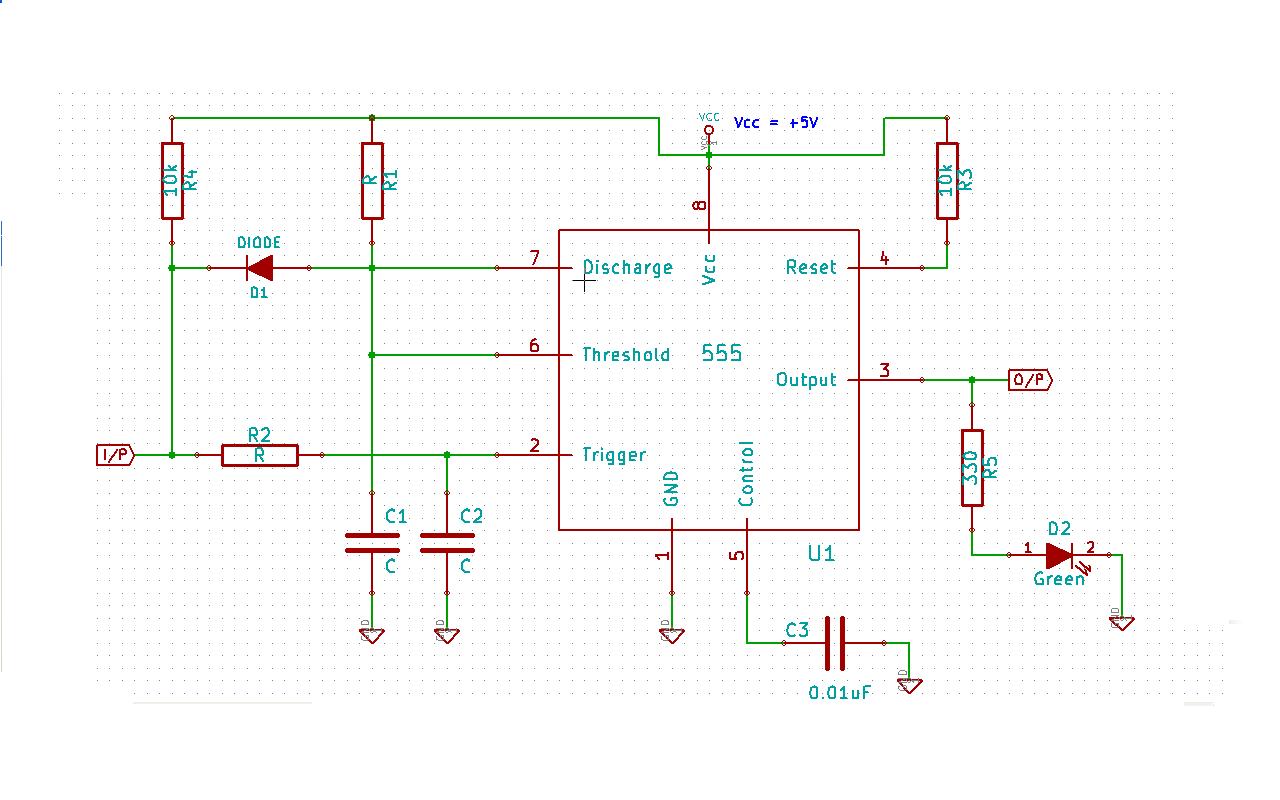
Create a 555 timer-based circuit where the output pin of the 555 timer is held low by default when powered on, and the input pin is held high at power on. The main requirement is that the output pin should go high only when the input pin is held low for approximately 200 milliseconds, and it must remain high as long as the input pin is low. What would occur if the control pin is pulled up to Vcc using a 1k resistor and the capacitor C3 is removed? Additionally, if the threshold pin is left unconnected and the anode of diode D1 is connected only to the discharge pin, R1, and C1, will the circuit still function as intended? Is the condition R2 x C2 < R1 x C1 necessary in this scenario? Suggestions are requested for values of R2, C2, R1, C1, and R4. Some tutorials recommend using electrolytic capacitors for C1 and C2 even for 1uF values, but it is unclear if this is necessary or if ceramic capacitors could be used instead. Considerations for reliable and accurate circuit operation are needed, with a tolerance of a few tens of milliseconds acceptable. Should higher capacitance for C2 and lower resistance for R2 be chosen, or vice versa, to achieve a typical of 1 second and a minimum of 880 milliseconds for 0.4 x R2 x C2? In a functional block diagram, the output Q of the flip-flop (FF) connects directly to pin 3, while output Q# connects to the base of a BJT. The 555 timer in monostable configuration suggests that the S-R flip-flop operates as a NOR gate. Initially, pin 3 is low, which can be maintained at power on by driving pin 4 low, causing the output Q of the FF to be low and pin 3 to latch low. When pin 2 becomes low (below 1/3 x Vcc), the output of the second comparator (Comp#2) goes high, making the S input of the FF high and causing the output Q to become high. Consequently, the BJT enters the cut-off region, allowing capacitor C1 to charge through R1. Even though the output of Comp#2 goes low as pin 2 returns to high, the output of the FF remains high due to its latch, provided that the values of C1 and R1 are selected correctly to ensure that R1 x C1 is greater than the pulse duration. It is crucial to prevent pin 6 from reaching 2/3 Vcc during the time pin 3 must remain high.
The 555 timer circuit described operates in a monostable configuration, leveraging the timer's ability to produce a single output pulse in response to a trigger signal on the input pin. The design ensures that the output pin (pin 3) remains low at power-up due to the inherent characteristics of the 555 timer and the connection of pin 4 to ground, which disables any unintended triggering.
For the circuit to function as intended, it is essential to select appropriate resistor and capacitor values. Resistor R1 and capacitor C1 form an RC timing circuit that dictates the duration for which the output remains high. The relationship R1 x C1 must exceed the desired pulse duration to ensure reliable operation. Capacitor C2 and resistor R2 are used to set the timing for the input signal; their values must be chosen carefully to meet the specified condition of R2 x C2 < R1 x C1 to avoid unintended behavior.
Regarding the choice of capacitors, electrolytic capacitors are often recommended for C1 and C2 in timing applications due to their higher capacitance values and voltage ratings. While ceramic capacitors can be used, their lower capacitance values may affect the timing characteristics of the circuit. The use of electrolytic capacitors may also provide better stability and reliability in the timing circuit, especially when dealing with longer durations.
The configuration of the flip-flop within the circuit allows for the output to remain latched high as long as the input condition is met. The diode D1 plays a critical role in controlling the discharge path of C1, ensuring that the timing sequence operates as intended. If the threshold pin is left unconnected, it could lead to unpredictable behavior, as the threshold level would not be properly defined, potentially causing the output to not behave as expected.
In summary, careful consideration of component values and configurations is necessary to achieve the desired timing characteristics and ensure reliable operation of the 555 timer-based circuit. The proper selection of resistors and capacitors, alongside the correct wiring of the flip-flop and diode, will facilitate the intended functionality of the circuit.Make a 555 timer base circuit such that O/P pin of 555 is held LOW by default at power on, and the I/P pin is held initially at HIGH at power on. The main requirement of my circuit is that until I/P pin is held LOW for say 200ms, then only the O/P pin must go HIGH and must remain HIGH as long as I/P pin is held LOW.
What will happen if I pull up the control pin to Vcc by say a 1k resistor and remove the capacitor C3 Is the functionality of this circuit affected in some way then I don`t remember where but I definitely saw such a circuit which have this pull-up resistor. What if I keep Threshold pin left unconnected and rest all is same in this circuit - ie anode of diode D1 is now connected only to Discharge pin, R1, C1 and not to Threshold pin!
Will now the circuit work to fulfill my purpose Is the condition R2xC2 < R1xC1 need to be hold true here This is in reference to this question actually. Any suggestions for values of R2, C2, R1, C1, and R4 On some tutorials it was specifically mention to use electrolytic capacitors for C1 and C2 here in schematic even for 1uF values (though they did not say that you must use electrolytic caps but they had drawn schematic with electrolytic caps.
). Is it necessary Will it make any difference Why can`t we use ceramic capacitors here for C1 and C2 I mean to say that what things I need to consider so that this circuit functions reliably and accurately. Absolute accuracy is not required - a tolerance of few tens of ms will work. Whether I should choose higher capacitance for C2 and lower resistance for R2, or higher resistance for R2 and lower capacitance for C2, for 0.
4 x R2 x C2 to be = 1 second typical and 880ms minimum Well, I thought that this update will be better to put as an answer rather that as an edit/update to Question. Also it would take too much space in Question. So I`m putting it here. In this functional block diagram, note that in effect, o/p Q of Flip-flop(FF) is directly connected to pin#3, and o/p Q# of FF is directly connected to base of BJT.
From the description of Working of 555 in monostable configuration, it seems to me that the S-R flip-flop(FF) is implemented as a NOR gate FF in functionality. Assume that the pin#3 is LOW at this point. (Pin#3 can be forced to LOW at power on by driving pin#4 to LOW. pin#4 when LOW causes the o/p Q of FF to be LOW and hence o/p pin#3 is latched at LOW. ) As soon as Pin#2 becomes LOW(< 1/3 x Vcc precisely), V- < V+ for Comp#2 and hence o/p of Comp#2 becomes HIGH.
This makes `S` i/p of Flip-flop(FF) HIGH, and hence we got S = 1(HIGH) and R = 0(LOW) condition at FF inputs. This o/p is latched by o/p stage and thus pin#3 becomes HIGH. At this point since Q# o/p of FF is LOW(Q = HIGH) so, the BJT is in cut-off region and hence high-side of C1 is now not at 0V.
Thus C1 starts charging via R1. During all this time, the Q output of FF will remain HIGH due to the latch of o/p stage of the FF, however the output of the Comp#2 will have become LOW as the V- will have become more positive(due to completion of pulse duration, pin#2 is returning to HIGH) than the V+ input of the comparator. Thus at this point, V- > V+ for Comp#2. => o/p of Comp#2 is LOW. => S = LOW. But since R = LOW too(V+ < V- as voltage across C1 has not yet reached at 2/3 of Vcc - see below), so o/p of the FF stays in its previous state ie Q = 1(HIGH).
This assumption can be guaranteed by choosing C1 and R1 values properly. I`m assuming here that values of C1 and R1 are chosen such that 1. 1 x R1 x C1 > pulse duration. Perhaps of course, pulse duration must be known in advance, as is the case here. Since as soon as pin#6 comes at 2/3 of Vcc, the discharging of C1 begins, we must somehow prevent reaching pin#6 to 2/3 x Vcc, for that duration for which we require the o/p pin#3 to remain HIGH. If we make pin#2 to HIGH, then D1 will again be rever 🔗 External reference
The 555 timer circuit described operates in a monostable configuration, leveraging the timer's ability to produce a single output pulse in response to a trigger signal on the input pin. The design ensures that the output pin (pin 3) remains low at power-up due to the inherent characteristics of the 555 timer and the connection of pin 4 to ground, which disables any unintended triggering.
For the circuit to function as intended, it is essential to select appropriate resistor and capacitor values. Resistor R1 and capacitor C1 form an RC timing circuit that dictates the duration for which the output remains high. The relationship R1 x C1 must exceed the desired pulse duration to ensure reliable operation. Capacitor C2 and resistor R2 are used to set the timing for the input signal; their values must be chosen carefully to meet the specified condition of R2 x C2 < R1 x C1 to avoid unintended behavior.
Regarding the choice of capacitors, electrolytic capacitors are often recommended for C1 and C2 in timing applications due to their higher capacitance values and voltage ratings. While ceramic capacitors can be used, their lower capacitance values may affect the timing characteristics of the circuit. The use of electrolytic capacitors may also provide better stability and reliability in the timing circuit, especially when dealing with longer durations.
The configuration of the flip-flop within the circuit allows for the output to remain latched high as long as the input condition is met. The diode D1 plays a critical role in controlling the discharge path of C1, ensuring that the timing sequence operates as intended. If the threshold pin is left unconnected, it could lead to unpredictable behavior, as the threshold level would not be properly defined, potentially causing the output to not behave as expected.
In summary, careful consideration of component values and configurations is necessary to achieve the desired timing characteristics and ensure reliable operation of the 555 timer-based circuit. The proper selection of resistors and capacitors, alongside the correct wiring of the flip-flop and diode, will facilitate the intended functionality of the circuit.Make a 555 timer base circuit such that O/P pin of 555 is held LOW by default at power on, and the I/P pin is held initially at HIGH at power on. The main requirement of my circuit is that until I/P pin is held LOW for say 200ms, then only the O/P pin must go HIGH and must remain HIGH as long as I/P pin is held LOW.
What will happen if I pull up the control pin to Vcc by say a 1k resistor and remove the capacitor C3 Is the functionality of this circuit affected in some way then I don`t remember where but I definitely saw such a circuit which have this pull-up resistor. What if I keep Threshold pin left unconnected and rest all is same in this circuit - ie anode of diode D1 is now connected only to Discharge pin, R1, C1 and not to Threshold pin!
Will now the circuit work to fulfill my purpose Is the condition R2xC2 < R1xC1 need to be hold true here This is in reference to this question actually. Any suggestions for values of R2, C2, R1, C1, and R4 On some tutorials it was specifically mention to use electrolytic capacitors for C1 and C2 here in schematic even for 1uF values (though they did not say that you must use electrolytic caps but they had drawn schematic with electrolytic caps.
). Is it necessary Will it make any difference Why can`t we use ceramic capacitors here for C1 and C2 I mean to say that what things I need to consider so that this circuit functions reliably and accurately. Absolute accuracy is not required - a tolerance of few tens of ms will work. Whether I should choose higher capacitance for C2 and lower resistance for R2, or higher resistance for R2 and lower capacitance for C2, for 0.
4 x R2 x C2 to be = 1 second typical and 880ms minimum Well, I thought that this update will be better to put as an answer rather that as an edit/update to Question. Also it would take too much space in Question. So I`m putting it here. In this functional block diagram, note that in effect, o/p Q of Flip-flop(FF) is directly connected to pin#3, and o/p Q# of FF is directly connected to base of BJT.
From the description of Working of 555 in monostable configuration, it seems to me that the S-R flip-flop(FF) is implemented as a NOR gate FF in functionality. Assume that the pin#3 is LOW at this point. (Pin#3 can be forced to LOW at power on by driving pin#4 to LOW. pin#4 when LOW causes the o/p Q of FF to be LOW and hence o/p pin#3 is latched at LOW. ) As soon as Pin#2 becomes LOW(< 1/3 x Vcc precisely), V- < V+ for Comp#2 and hence o/p of Comp#2 becomes HIGH.
This makes `S` i/p of Flip-flop(FF) HIGH, and hence we got S = 1(HIGH) and R = 0(LOW) condition at FF inputs. This o/p is latched by o/p stage and thus pin#3 becomes HIGH. At this point since Q# o/p of FF is LOW(Q = HIGH) so, the BJT is in cut-off region and hence high-side of C1 is now not at 0V.
Thus C1 starts charging via R1. During all this time, the Q output of FF will remain HIGH due to the latch of o/p stage of the FF, however the output of the Comp#2 will have become LOW as the V- will have become more positive(due to completion of pulse duration, pin#2 is returning to HIGH) than the V+ input of the comparator. Thus at this point, V- > V+ for Comp#2. => o/p of Comp#2 is LOW. => S = LOW. But since R = LOW too(V+ < V- as voltage across C1 has not yet reached at 2/3 of Vcc - see below), so o/p of the FF stays in its previous state ie Q = 1(HIGH).
This assumption can be guaranteed by choosing C1 and R1 values properly. I`m assuming here that values of C1 and R1 are chosen such that 1. 1 x R1 x C1 > pulse duration. Perhaps of course, pulse duration must be known in advance, as is the case here. Since as soon as pin#6 comes at 2/3 of Vcc, the discharging of C1 begins, we must somehow prevent reaching pin#6 to 2/3 x Vcc, for that duration for which we require the o/p pin#3 to remain HIGH. If we make pin#2 to HIGH, then D1 will again be rever 🔗 External reference
Warning: include(partials/cookie-banner.php): Failed to open stream: Permission denied in /var/www/html/nextgr/view-circuit.php on line 713
Warning: include(): Failed opening 'partials/cookie-banner.php' for inclusion (include_path='.:/usr/share/php') in /var/www/html/nextgr/view-circuit.php on line 713
